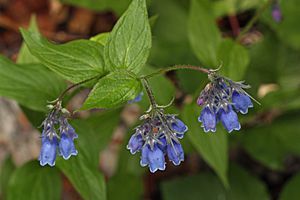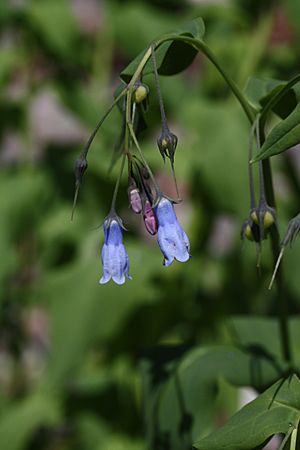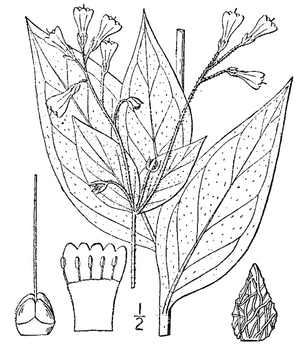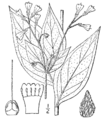Tall lungwort facts for kids
Quick facts for kids Tall lungwort |
|
|---|---|
 |
|
| Mertensia paniculata (upper Matanuska River Valley, Alaska) | |
| Scientific classification | |
| Genus: |
Mertensia (plant)
|
| Species: |
paniculata
|
| Synonyms | |
|
|
Mertensia paniculata, also known as the tall lungwort, tall bluebells, or northern bluebells, is an herb or dwarf shrub. It has beautiful drooping, bright-blue, bell-shaped flowers. This plant naturally grows in northwestern North America and the Great Lakes region.
Contents
Where Does the Northern Bluebell Grow?
The Mertensia paniculata plant is found in the temperate zone of North America. It loves to grow in boreal forests, which are cool, northern forests.
You can find the northern bluebell in Canada, especially in southern British Columbia. In the United States, it grows in Alaska. It also stretches east from the Olympic Mountains through Oregon to Idaho and western Montana. You might even spot it as far east as Michigan, Wisconsin, and Minnesota.
Where Do Bluebells Live and Grow?
The northern bluebell grows best in moist areas like forests or meadows. It can handle shade well. This plant is found in both early and late-seral communities, which means it can appear at different stages of an ecosystem's development.
It is most common in the middle stages of growth. However, it has been seen growing in Alaska and Canada after events like fires or logging. This plant can regrow from parts of its roots called rhizomes that are buried in the soil. It can also sprout from parts left on the surface.
The northern bluebell likes soil that is moist (called mesic), cool, and doesn't have too many nutrients. It is a perennial plant, meaning it lives for more than two years. Studies in the Yukon region show it's a common plant there, even with only 230 mm of rain each year and an average temperature of −3° Celsius. Its flowers usually bloom from May to September, depending on the area.
What Does the Northern Bluebell Look Like?
This plant can be a leafy herb or a small shrub. It grows one to several straight stems from a long root. These stems can be from 0.1 to 0.7 meters tall and usually have very little hair.
The leaves at the bottom of the plant are large, from 0.05 to 0.2 meters long and 0.025 to 0.1 meters wide. They can be wide, oval-shaped, or heart-shaped, and they narrow to a point at the tip. The underside of the leaves can be smooth or have a few hairs. The top surface can have short, stiff bristles or be completely smooth.
The leaves have veins like a feather and have long stems (petioles) from 0.1 to 0.25 meters long. Higher up the plant, the leaves are smaller, from 0.05 to 0.18 meters long and 0.01 to 0.08 meters wide. They are broad and oval-shaped with pointed ends. The leaves grow in an alternating pattern up the stem. The flowers grow in a spiral shape, called a scorpioid cyme.
Flowers, Fruit, and Reproduction

The flowers of M. paniculata have both male and female parts. They have five blue petals, which are often pink when they are young. Very rarely, a mature flower might have white petals. The five green leaf-like parts that hold the petals (called sepals) are long and narrow, with tiny hairs along their edges. The underside of the sepals can be smooth or have short, stiff hairs.
The tube of the flower is about 0.0045 to 0.007 meters long. The parts that hold pollen (anthers) are about 0.0022 to 0.0033 meters long. The style, which is part of the female reproductive system, is as long as or longer than the petals.
The fruit of the tall lungwort are small, wrinkled, single-seeded parts called nutlets. There are usually 1 to 4 of these nutlets in a cluster, and they are about 0.0025 to 0.005 meters long.
Bees are the only known animals that pollinate this plant. The plant can also reproduce by growing new plants from its roots, forming a cluster around the parent plant. After a fire, it has been seen spreading sideways using its roots. This suggests it can regrow by sprouting new shoots.
How People Use Northern Bluebells
Food and Medicine
Even though you can't eat the whole plant, the tall bluebell has been used in the past as a pot-herb (a plant cooked like a vegetable) in northern areas and in Scotland. This is because it belongs to the borage family, which includes some edible plants.
It has also been used for medicine. People would dry the leaves and make them into an herbal tea. This tea was thought to help with breathing problems.
Images for kids



